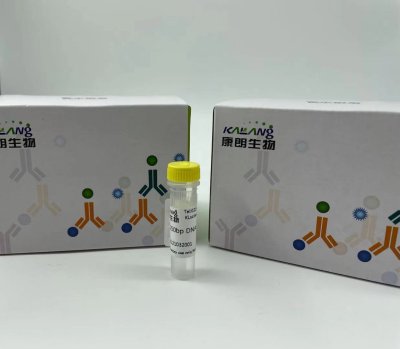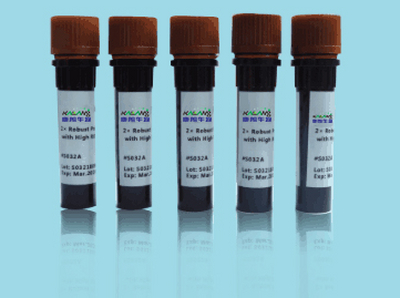QQ:3002763590


客服电话:021-61998208
Anti a1AGP polyclonal antibody
a1AGP抗体
Anti a1AGP polyclonal antibodyAlpha-1-acid glycoprotein 1 (AGP1), also called orosomucoid-1 (ORM1), is a glycoprotein synthesized mostly by hepatocytes and present in human plasma. ORM1 is an acute-phase reactant protein controlled by glucocorticoids, interleukin-1 and interleukin-6, and increase up to 5-50 times upon infection and/or inflammation. Anti-apoptotic effect and role as immunomodulator of ORM have been reported. ORM is an important carrier for synthetic drugs and influences their distribution and availability in the body. This antibody recognizes a band about 44 kDa in human plasma which may be due to the glycosylation of ORM1 or the dimer formation of the protein.
Anti CD1b polyclonal antibody
CD1b抗体
Anti CD1b polyclonal antibodyThis gene encodes a member of the CD1 family of transmembrane glycoproteins, which are structurally related to the major histocompatibility complex (MHC) proteins and form heterodimers with beta-2-microglobulin. The CD1 proteins mediate the presentation of primarily lipid and glycolipid antigens of self or microbial origin to T cells. The human genome contains five CD1 family genes organized in a cluster on chromosome 1. The CD1 family members are thought to differ in their cellular localization and specificity for particular lipid ligands. The protein encoded by this gene localizes to late endosomes and lysosomes via a tyrosine-based motif in the cytoplasmic tail, and requires vesicular acidification to bind lipid antigens.
Anti GLUT4 polyclonal antibody
GLUT4抗体
Anti GLUT4 polyclonal antibodyGLUT4 is a member of GLUT family of transmembrane hexose transporters. It is an insulin receptor that mediates insulin-stimulated glucose transport in fat and muscle where it is predominantly expressed. In response to insulin stimulation, GLUT4 experienced translocation from trans-Golgi network to plasma membrane. The impairment of GLUT4 translocation is associated with diabetes.
Anti OTUB2 polyclonal antibody
OTUB2抗体
Anti OTUB2 polyclonal antibodyThis gene encodes one of several deubiquitylating enzymes. Ubiquitin modification of proteins is needed for their stability and function,to reverse the process, deubiquityling enzymes remove ubiquitin. This protein contains an OTU domain and binds Ubal (ubiquitin aldehyde),an active cysteine protease site is present in the OTU domain.
Anti TrKB polyclonal antibody
TrKB抗体
Anti TrKB polyclonal antibodyThe Trk family of nerve growth factor receptors includes Trk A(also referfed to as Trk A gp140),Trk B and Trk C. The prototype member of this gene family, Trk A, encodes a 140 kDa cell surface receptor, gp140, the expression of which is restricted in vivo to neurons of the sensory spinal and cranial gangliaof neurocrest origin. Nerve growth factor (NGF) stimulates tyrosine phosphorylation of Trk gp 140 in neural cell lines and in embryonic dorsal root ganglia. By comparison, BDNF and to a lesser extent, NT-3, but not NGF, can induce tyrosine phophorylayion of Trk B gp 145. The third member of the Trk receptor family, Trk C incodes a 140 kDa protein, Trk C gp140, that is preferentially expressed in brain tissue and primarily functions as a receptor for NT-3.An additional component of the Trk receptor complex, NGFR p175, binds to neurotrophic factors with low affinity but is required for efficient signaling. NGFR p175 accelerates Trk activation and may recrui
Anti MAP3K7 polyclonal antibody
MAP3K7抗体
Anti MAP3K7 polyclonal antibodyMAP3K7(Mitogen-activated protein kinase kinase kinase 7) is also named as TAK1 and belongs to the MAP kinase kinase kinase subfamily.It plays an important role in the cascades of cellular responses evoked by changes in the environment.It has been linked to interleukin-1 receptor and tumor necrosis factor receptor signaling (PMID: 16186825).It has 4 isoforms (53-55 kDa,64-70 kDa and 75-80 kDa)produced by alternative splicing.
Anti MGP polyclonal antibody
MGP抗体
Anti MGP polyclonal antibodyMatrix Gla protein (MGP), a vitamin K-dependent protein, is recognized as a calcification inhibitor in vascular tissue. Defects in MGP are the cause of Keutel syndrome (KS), which is an autosomal recessive disorder characterized by abnormal cartilage calcification, peripheral pulmonary stenosis neural hearing loss and midfacial hypoplasia.
Anti UCN3 polyclonal antibody
UCN3抗体
Anti UCN3 polyclonal antibodyUrocortin 3 is a member of the sauvagine/corticotropin-releasing factor/urotensin I family. It is structurally related to the corticotropin-releasing factor (CRF) gene and the encoded product is an endogenous ligand for CRF type 2 receptors. In the brain it may be responsible for the effects of stress on appetite. In spite of the gene family name similarity, the product of this gene has no sequence similarity to urotensin II.
Anti TRAF6 polyclonal antibody
TRAF6抗体
Anti TRAF6 polyclonal antibodyTRAF6 is a member of the TNF receptor associated factor (TRAF) protein family. TRAF6 is recognized as a signal transducer, which activates the NF-κB pathway in response to pro-inflammatory cytokines. TRAF6 has E3 ligase activity and is responsible for inducing Lys-63 (K63)-linked poly-ubiquitination chains, functioning together with E2 Ubc13/Uev1A complex to mediate IKK activation TRAF6 plays a crucial role in the regulation of the innate and adaptive immune responses.
Anti SREBP1 polyclonal antibody
SREBP1抗体
Anti SREBP1 polyclonal antibodySREBF1, also named as BHLHD1 and SREBP1, contains one basic helix-loop-helix (bHLH) domain and belongs to the SREBP family. It is a transcriptional activator required for lipid homeostasis. The SREBPs are synthesized as precursors anchored to endoplasmic reticulum (ER) membranes and complexed with SCAP. When the cellular cholesterol level is low, SREBP-SCAP complexes move to the Golgi apparatus, where SREBPs undergo a two-step proteolytic processing, leading to the release of the mature form, an N-terminal fragment, i.e, basic helix-loop-helix leucine zipper transcription factor. These factors enter the nucleus where they bind to sterol regulatory elements (SRE) in the promoter regions of a number of genes whose products mediate the synthesis of cholesterol and fatty acids. [PMID: 21698267]. This antibody can recognize the 125kd precursor form and the 68kd mature form of human SREBF1.
最新动态
-

Anti-GNGT1 KL20092-001(50ul)
2021-10-11 -

Anti-GNGT1 antibody(50ul) KL20093-001
2021-10-11 -

MUC5AC (PT2058) mouse Monoclonal Antibody
2021-01-06 -

mOrange mouse Monoclonal Antibody(Mix)
2021-01-05
热门标签
- Histone H3 rabbit Polyclonal Antibody Histone H3抗体
- EGFR rabbit Polyclonal Antibody EGFR抗体
- Cy3 Conjugated
- AbFluor™ 555 Conjugated
- AbFluor™ 680 Conjugated
- AbFluor™ 350 Conjugated
- AbFluor™ 647 Conjugated
- AbFluor™ 594 Conjugated
- AbFluor™ 405 Conjugated
- Cy5 Conjugated
- AbFluor™ 488 Conjugated
- Cyclophilin B抗体 Cyclophilin B Monoclonal Antibody(2B10)
- COX IV抗体 COX IV Monoclonal Antibody(6C8)
- PCNA抗体 PCNA Monoclonal Antibody(12D10)
- FAK rabbit Polyclonal Antibody FAK抗体
邮箱:3002763590@qq.com
电话:021-61998208

扫码关注微信公众号















